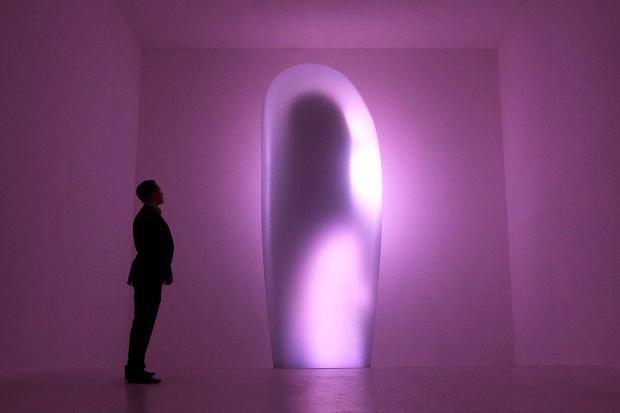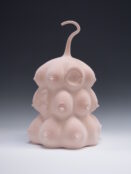[dropcap style=”font-size:100px; color:#992211;”]W[/dropcap]hen I visited London earlier this month, I had the unusual luxury of time.
I decided to spend it looking at just one artwork in the Mariko Mori exhibition – as kind of experiment: What would happen if I sat in the same gallery space at the Royal Academy, gazing and pondering this work for a whole hour? Here’s how it went:
The sculpture is the one in all the press shots – a giant, organic chrysalis-like sculpture, containing pulsing lights, named Tom Na H-iu after a place where transmigrated souls were believed to rest in ancient Celtic religion. The piece is a large glass monolith five metres high, lit from within by hundreds of LED lights and connected to Super Kamiokande, Institute for Cosmic Ray Research at The University of Tokyo. The observatory detects neutrinos emitted by the sun, the earth’s atmosphere and during a supernova. The work displays these in real time, in constantly changing light patterns.
Because of the softness of this sculpture, and the gentle fading in and out of light, it is an object that you cannot focus on, so gazing at it is akin to gazing at a flame. I became mesmerized, like looking at a candle or the sea. No doubt these meditative and mesmeric qualities are all part of its design, the universal themes of life, death and rebirth being key themes of Mori’s work: Recent artworks have evolved around a fascination with ancient cultures, among them prehistoric Jomon (c.14,000 – 300 BC) in Japan, and Celtic traditions in Europe.
But rather than ‘getting’ this symbolism, and then wandering on to the next piece. I wanted to challenge myself to actually experience the artwork this way. And here is how it felt:
The sculpture is very much about the light and shadow, less about a solid form – the experience of the work is the presence of atmosphere it creates. It does not feel entirely solid, and whether you realize it or not, the artwork extends outside its pod-like shape and also includes the dimming and brightening of the walls in the room: the switching between a dark shape against a faintly lit room, and the soft luminance of an object in a black space.
The floor is gently sloping upwards, simulating the way the ground might run if this were a piece of Stonehenge or an ancient monument worshiping the lunar. Occasionally, the light fades all together, and the sudden pitch blackness is thicker, more physical and immersive than the delicate light of the artwork that has just faded out, and will reappear in a few beats.
I tried to focus purely on the undulating light and dark, not the fact I was in an exhibition, or the creaking of the floorboards as people wandered in and out, or even the room around me. Whenever I had other thoughts or my mind started working on something in the background, I gradually brought it back and tried to put my whole mind to the singular focus point of the sculpture.
I wouldn’t call this meditation but the techniques are those that you might use in a meditation, and given the artist’s references, this felt like a fitting way to experience the work – and one that most of its viewers would probably not be able to pay it the full honor of doing in this fast paced city.
During the time that I sat there, many people drifted in and out, some sitting with me, some standing, some lingering, some going right up to the sculpture, other inquisitive visitors venturing behind it. These provided more of a challenge to my focus, but in the end they were interesting to observe, as they turned into human-shaped patches of dark to contrast the light.
[quote]it’s making my brain hurt[/quote]
Two separate people talked to me about how it made them feel – calm and at peace, bigger and with more presence than they had imagined from pictures, glorious. Others apologized for having to go up to and look at the sculpture – they hoped they had not got in my way, but they felt compelled to see behind this looming beacon. Others found it all too much “it changes your perception doesn’t it?”, “it’s making my brain hurt, let’s go”, they said to each other.
The fading in and out of the light happened all across the surface of this curved shape and encroached around the edges of the sculpture when it was lighting up on the reverse – like beams of a sunrise bending round the curve of the earth or over a garden wall. It was like sunrise after sunrise after sunrise. On two occasions I spotted the briefest curlicue of blue light, which seemed something special as it happened only once every 30 mins. I wonder: ‘did that represent something different Mariko?’.
Eventually I peeled myself away and emerged blinking into the daylight, feeling strangely floaty. In a way, this experience of an artwork is a little like the experience of an artist when making an artwork – being so completely absorbed by it that it fills up your eyes so you see nothing else. It fills you up mentally too, as you focus only on creating it, and the outside world fades away.
If you fancy seeing what it feels like to be an artist and become completely lost in a drawing, or entirely occupied by the intensity of the paint, I’d advise giving this a try.
Mariko Mori: Rebirth @ Royal Academy, 13 December 2012—17 February 2013
[button link=”http://www.royalacademy.org.uk/exhibitions/mariko-mori/” newwindow=”yes”] Exhibition Details[/button]
Nicola Anthony is a British artist known for her public art around the world. Her text sculptures are made of metal, words, memories and narratives. She has worked internationally with NGOs, art institutions, public spaces and cultural research bodies to create art which tells the stories that are often left unspoken.






















